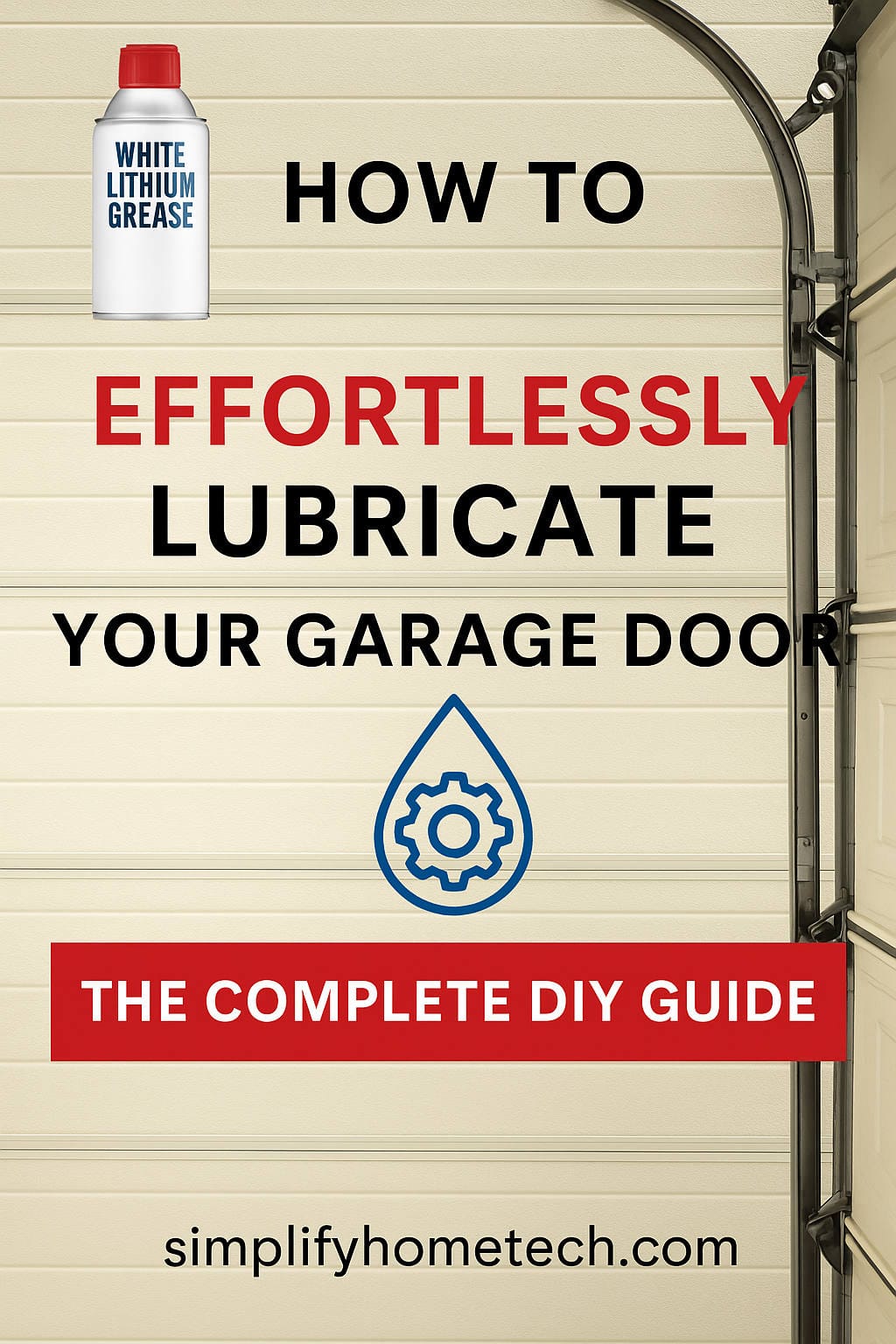A well-functioning garage door is vital for the safety, convenience, and energy efficiency of your home. But just like any other mechanical system, your garage door needs regular care to operate smoothly. One of the easiest and most impactful maintenance tasks is proper lubrication—a simple step that can prevent breakdowns, eliminate annoying noises, and extend the life of your garage door system.
In this comprehensive, step-by-step guide, you’ll learn how to effortlessly lubricate your garage door, the best products to use, what parts to target, common mistakes to avoid, and additional maintenance tips to keep your door working like new. Whether you’re a seasoned DIYer or a first-timer, this guide is designed to help you confidently maintain your garage door without calling in a pro.
Why Garage Door Lubrication Is So Important
Garage doors are heavy, complex systems with multiple moving parts that work together under constant tension and pressure. These parts—including rollers, hinges, tracks, and springs—are in frequent motion, which leads to wear and tear over time.
Here’s why regular lubrication is crucial:
✅ Reduces Friction
Lubrication minimizes friction between metal components, preventing excessive wear and noisy operation.
✅ Extends Component Lifespan
A well-lubricated garage door lasts longer. Rollers, hinges, and springs won’t grind themselves into premature failure.
✅ Prevents Rust and Corrosion
Quality lubricants create a protective barrier against moisture and air, shielding metal parts from rust.
✅ Enhances Door Performance
Lubrication ensures the door opens and closes smoothly, reducing strain on the opener and improving safety.
✅ Saves Money
Neglected garage doors often need expensive repairs or complete part replacements. Routine lubrication can prevent those costs.
Signs Your Garage Door Needs Lubrication
Recognizing when your garage door needs lubrication can save you time and money. Look out for these telltale signs:
- Squeaking, grinding, or screeching noises
- Jumpy or jerky movement when opening or closing
- Stiff or stuck components
- Visible rust or residue on hardware
- Garage door opener working harder than usual
If your door exhibits any of these symptoms, it’s time to grab your lubricant and get to work.
What You’ll Need: Tools & Materials Checklist
Before you begin, make sure you have the following items ready:
✔ Essential Tools:
- Step ladder (for reaching high parts)
- Clean, lint-free rags or paper towels
- Screwdriver or wrench (for tightening loose parts)
- Mild household cleaner or degreaser
✔ Safety Gear:
- Protective gloves
- Safety goggles
✔ The Right Lubricant:
Not all lubricants are created equal. Avoid using household oils like WD-40 as a primary solution—it’s a degreaser, not a long-term lubricant.
Recommended Garage Door Lubricants:
- White Lithium Grease Spray – Ideal for metal-to-metal surfaces; clings well and withstands temperature changes.
- Silicone-Based Lubricant – Best for plastic parts or components with rubber seals; resists water and dust.
- Garage Door-Specific Lubricants – Products such as 3-IN-ONE Garage Door Lubricant are formulated specifically for door components.
Safety First: Precautions to Take Before Starting
Before performing any maintenance, follow these safety steps:
- Disconnect the garage door opener to prevent accidental activation.
- Ensure the door is in a down (closed) position to avoid injury.
- Wear gloves and goggles to protect from sharp parts and dripping lubricant.
Step-by-Step: How to Effortlessly Lubricate Your Garage Door
Now that you’re ready, follow these simple steps to properly lubricate your garage door system.
🔧 Step 1: Clean All Moving Parts
Before applying any lubricant, remove dirt, dust, and old grease buildup.
- Use a dry cloth to wipe down rollers, tracks, hinges, and springs.
- For stubborn grime, spray a mild degreaser or household cleaner, then wipe clean.
- Let all components dry completely before proceeding.
Why this matters: Dirt and debris mixed with new lubricant can create a sticky, abrasive paste that accelerates wear.
🔧 Step 2: Lubricate the Rollers
The rollers help your door move up and down the tracks smoothly. There are two common types:
- Steel Rollers: Spray directly on the ball bearings and shaft.
- Nylon Rollers: Only lubricate the bearings (if exposed); avoid getting lubricant on nylon wheels.
Tip: If your nylon rollers have sealed bearings, they do not require lubrication.
🔧 Step 3: Lubricate the Hinges
The hinges allow each panel of the door to bend as it opens and closes.
- Apply lubricant at the pivot points.
- Avoid spraying hinges that are connected to nylon rollers to prevent damage to the nylon.
A few sprays per hinge are enough—excess lubricant can attract dust and dirt.
🔧 Step 4: Lubricate the Springs
Garage door springs are under extreme tension and help balance the door’s weight. Lubricating them is essential to reduce noise and extend their lifespan.
- Stand at a safe distance and spray torsion or extension springs along their full length.
- Operate the door manually a few times to distribute the lubricant.
Caution: Never attempt to adjust or repair springs yourself—they can be dangerous and should only be serviced by professionals.
🔧 Step 5: Lubricate the Bearing Plates and Pulleys
- Bearing plates are located at each end of the torsion spring shaft.
- Spray the center of the plates where they meet the shaft.
- If your door uses extension springs, also lubricate the pulleys at each end of the springs.
🔧 Step 6: Lubricate the Arm Bar and Manual Lock
- Lubricate the curved arm bar that connects the door to the opener trolley.
- If your door has a manual lock or keyhole, spray lubricant inside to prevent jamming.
This ensures all parts remain functional, especially during power outages or emergencies.
🔧 Step 7: Clean and Lightly Treat the Tracks (Optional)
- Clean tracks using a damp rag—remove any buildup of dust or grease.
- Do not lubricate the tracks directly. This can cause the rollers to slip and wear unevenly.
- If absolutely necessary, a very light spray of silicone can be used on vertical sections of the track.
🔧 Step 8: Test the Door
Once all parts are lubricated:
- Reconnect the power to your garage door opener.
- Open and close the door several times to allow the lubricant to spread evenly.
- Listen for noise and observe the motion. It should be smooth and quiet.
How Often Should You Lubricate Your Garage Door?
The frequency of lubrication depends on how often your garage door is used and your local climate.
- Regular households (2–4 uses/day): Every 6 months
- High-traffic households (5+ uses/day): Every 3–4 months
- Extreme weather regions: Every 3 months
Set reminders on your phone or calendar so you never forget.
Common Lubrication Mistakes to Avoid
Even the best intentions can go wrong if you don’t avoid these common pitfalls:
❌ Using the Wrong Product
Using WD-40 or heavy greases can do more harm than good. Always use products designed for garage doors.
❌ Overlubricating
Too much lubricant can attract dirt and cause gunk buildup. Less is more.
❌ Skipping the Cleaning Step
Applying lubricant over dirt and old grease just creates a sticky mess that may hinder operation.
❌ Lubricating Tracks
Tracks are designed to guide rollers, not be slippery. Keep them clean, not greased.
❌ Ignoring Safety
Garage door springs and cables are under extreme tension. Never adjust or remove them unless you’re a trained technician.
Extra Maintenance Tips for a Healthier Garage Door
Lubrication is just one part of garage door care. Here are additional tips to maximize your system’s lifespan:
✅ Tighten Loose Hardware
Garage doors move up and down thousands of times each year. Vibration can loosen bolts and screws. Check and tighten them periodically.
✅ Inspect the Weatherstripping
Check the rubber seal at the bottom of the door. Replace it if it’s cracked or brittle to keep out drafts and pests.
✅ Check Door Balance
Disconnect the opener and manually lift the door halfway. It should stay in place. If it doesn’t, the springs may need adjustment—call a pro.
✅ Listen for Noises
Strange sounds could mean something’s wrong. Grinding may indicate worn rollers; popping could point to spring issues.
When to Call a Professional
While lubrication and basic maintenance are DIY-friendly, some situations require an expert:
- Broken or stretched springs
- Frayed or snapped cables
- Bent tracks
- Malfunctioning garage door opener
- Unusual noises that don’t resolve with lubrication
Don’t risk injury—professional garage door technicians have the tools and experience to handle complex repairs safely.
Best Garage Door Lubricants to Buy
Here are some top-rated, homeowner-approved lubricants:
| Product | Type | Best For |
|---|---|---|
| 3-IN-ONE Garage Door Lubricant | Silicone | Hinges, springs, rollers |
| Blaster Garage Door Lubricant | Teflon-enhanced silicone | Cold weather, all components |
| WD-40 Specialist White Lithium Grease | Lithium-based | Heavy-duty metal parts |
| Lubriplate Aero L Grease | Lithium | Professional-grade lubrication |
You can find these products online or at your local home improvement store.
Frequently Asked Questions (FAQs)
Q: Can I use WD-40 to lubricate my garage door?
A: WD-40 is primarily a degreaser and rust remover. It’s not a suitable long-term lubricant for garage door parts.
Q: What parts of my garage door should NOT be lubricated?
A: Avoid lubricating the tracks directly. Also, don’t lubricate plastic components or sealed bearings unless the manufacturer specifies.
Q: How long does it take to lubricate a garage door?
A: A complete lubrication session typically takes 20 to 30 minutes.
Q: My garage door is still noisy after lubrication. What should I do?
A: Persistent noise may signal worn parts like rollers or hinges. Inspect them visually or consult a technician for a deeper diagnosis.
Final Thoughts: Keep Your Garage Door Quiet, Smooth, and Safe
Regular garage door lubrication is one of the most cost-effective ways to maintain your home. With just a bit of time and the right products, you can reduce noise, prevent damage, and extend the life of your door system.
Here’s a quick recap of what to do:
- Use a white lithium or silicone-based spray
- Clean all moving parts before lubricating
- Focus on rollers, hinges, springs, bearings, and locks
- Lubricate every 3 to 6 months, depending on usage
- Don’t forget regular inspections and other maintenance tasks
Your garage door works hard—give it the care it deserves with a simple lubrication routine.

